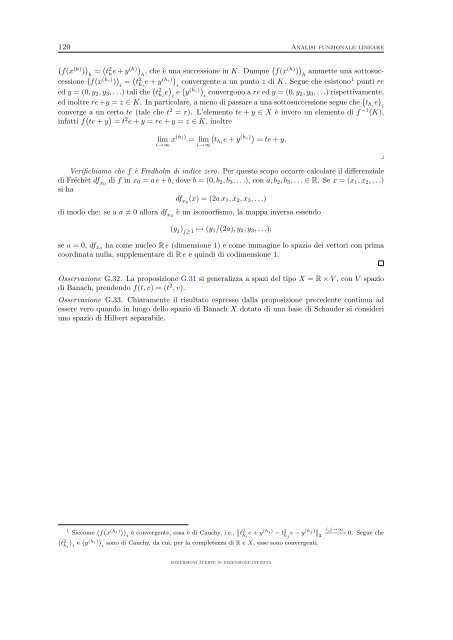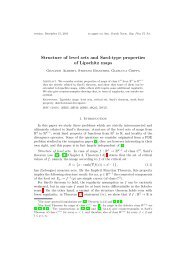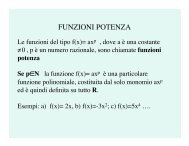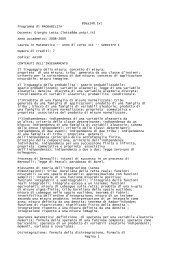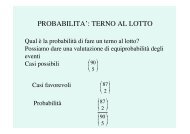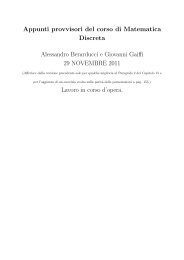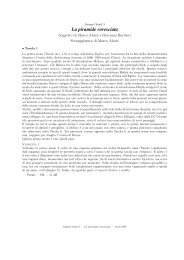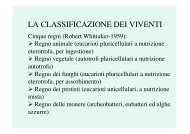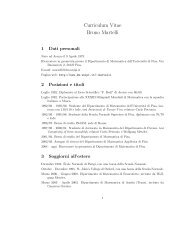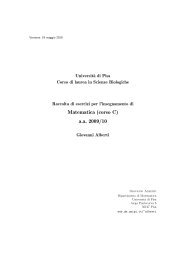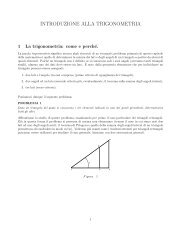Immersioni aperte in dimensione infinita - Dipartimento di Matematica
Immersioni aperte in dimensione infinita - Dipartimento di Matematica
Immersioni aperte in dimensione infinita - Dipartimento di Matematica
You also want an ePaper? Increase the reach of your titles
YUMPU automatically turns print PDFs into web optimized ePapers that Google loves.
120 Analisi funzionale l<strong>in</strong>eare<br />
<br />
(h) f(x ) h = t2 he + y(h)h<br />
, che è una successione <strong>in</strong> K. Dunque f(x (h) ) <br />
ammette una sottosuc-<br />
h<br />
cessione f(x (hi) ) <br />
i = t2 e + y(hi)<br />
hi i convergente a un punto z <strong>di</strong> K. Segue che esistono1 punti re<br />
ed y = (0, y2, y3, . . .) tali che t2 hiei e y (hi)<br />
i convergono a re ed y = (0, y2, y3, . . .) rispettivamente,<br />
ed <strong>in</strong>oltre re+y = z ∈ K. In particolare, a meno <strong>di</strong> passare a una sottosuccessione segue che thie <br />
i<br />
converge a un certo te (tale che t2 = r). L’elemento te + y ∈ X è <strong>in</strong>vero un elemento <strong>di</strong> f −1 (K),<br />
<strong>in</strong>fatti f te + y = t2e + y = re + y = z ∈ K, <strong>in</strong>oltre<br />
lim<br />
i→∞ x(hi) <br />
= lim thie + y<br />
i→∞<br />
(hi) = te + y.<br />
Verifichiamo che f è Fredholm <strong>di</strong> <strong>in</strong><strong>di</strong>ce zero. Per questo scopo occorre calcolare il <strong>di</strong>fferenziale<br />
<strong>di</strong> Fréchèt df x0 <strong>di</strong> f <strong>in</strong> x0 = a e + b, dove b = (0, b2, b3, . . .), con a, b2, b3, . . . ∈ R. Se x = (x1, x2, . . .)<br />
si ha<br />
df x0 (x) = (2a x1, x2, x3, . . .)<br />
<strong>di</strong> modo che: se a a = 0 allora df x0 è un isomorfismo, la mappa <strong>in</strong>versa essendo<br />
(yj) j≥1 ↦→ (y1/(2a), y2, y3, . . .);<br />
se a = 0, dfx0 ha come nucleo R e (<strong><strong>di</strong>mensione</strong> 1) e come immag<strong>in</strong>e lo spazio dei vettori con prima<br />
coord<strong>in</strong>ata nulla, supplementare <strong>di</strong> R e e qu<strong>in</strong><strong>di</strong> <strong>di</strong> co<strong><strong>di</strong>mensione</strong> 1.<br />
Osservazione G.32. La proposizione G.31 si generalizza a spazi del tipo X = R × V , con V spazio<br />
<strong>di</strong> Banach, prendendo f(t, v) = (t 2 , v).<br />
Osservazione G.33. Chiaramente il risultato espresso dalla proposizione precedente cont<strong>in</strong>ua ad<br />
essere vero quando <strong>in</strong> luogo dello spazio <strong>di</strong> Banach X dotato <strong>di</strong> una base <strong>di</strong> Schauder si consideri<br />
uno spazio <strong>di</strong> Hilbert separabile.<br />
<br />
1 Siccome f x (hi) <br />
i è convergente, essa è <strong>di</strong> Cauchy, i.e., t2 h e + y<br />
i (hi) − t2 e − y hj (hj ) i,j→∞ −−−−−→ 0. Segue che<br />
2<br />
<br />
t2 hi i e y (hi) <br />
sono <strong>di</strong> Cauchy, da cui, per la completezza <strong>di</strong> R e X, esse sono convergenti.<br />
i<br />
IMMERSIONI APERTE IN DIMENSIONE INFINITA


